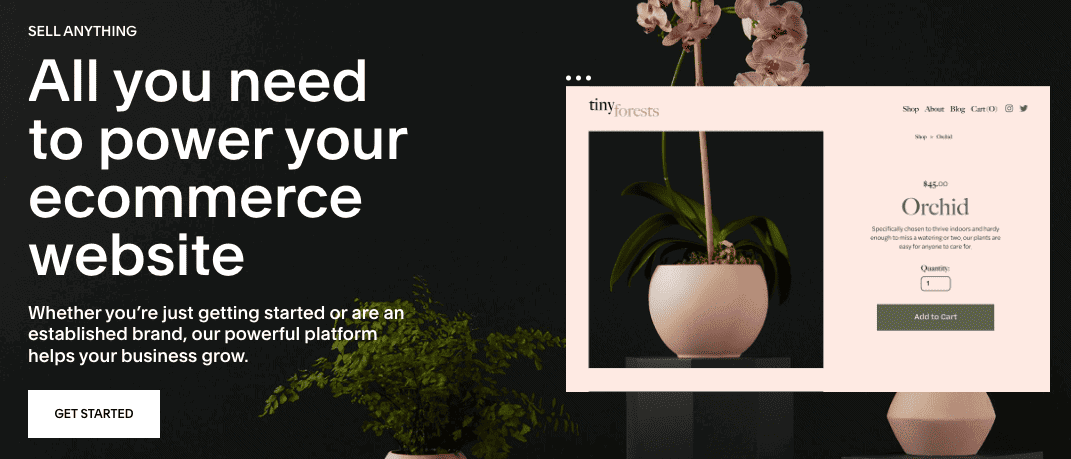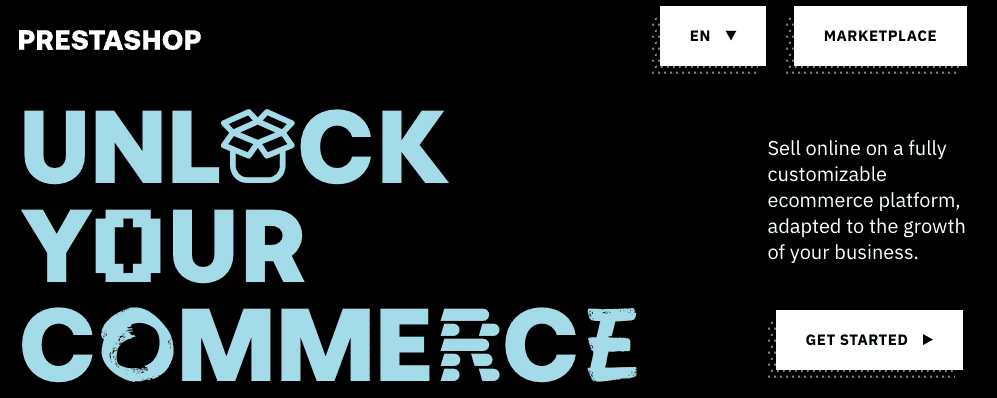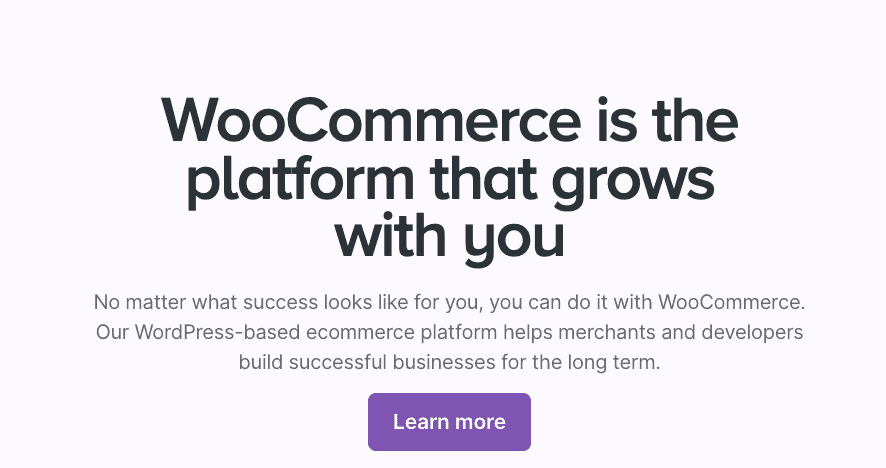As an entrepreneur or a small business owner, you might question the need for Shopify alternatives when leading industry giants like Sephora and PepsiCo swear by it. But the more important and interesting question is — is Shopify ideal for you?
No cloud-based multi-channel eCommerce platform is a one-size-fits-all solution. Whether you choose Shopify or its alternatives, your decision should hinge on crucial concerns like ease of use, cost, and customization requirements.
So, in this handy guide, we’ll take you through:
- 7 top Shopify alternatives and their features
- Pros and cons
- Pricing plans
- User reviews
- A sound framework for choosing Shopify alternatives
Let’s dive right in.
Table of Contents
Key Takeaways
- BigCommerce, Magento (Adobe Commerce), and WooCommerce are robust, customizable, and scalable Shopify alternatives for established businesses looking for control over their website and wanting to scale up.
- Wix and Squarespace are feasible Shopify alternatives for small and medium businesses focused on design and establishing a brand identity.
- Ecwid is an excellent option for small to medium businesses wanting simple add-on stores, as the platform gives several widgets and plugins.
- PrestaShop is a perfect Shopify alternative for a small to medium-sized tech-savvy team looking for a budget-friendly option, as it is open-source and fully customizable.
- When choosing a Shopify alternative that best fits their needs, Small businesses must consider scalability, technical expertise, add-on costs, expected profit margins, and long-term goals.
Why Consider Alternatives to Shopify?
You’re probably looking for Shopify alternatives because of some potential limitations. Here’s why several small businesses search for alternatives to Shopify in 2025.
Limited scalability for stores with larger catalogs
A true nightmare for any small business is drowning in a sea of orders while needing more tools and capacity to fulfill them.
While Shopify Plus offers several added features to scale your business, a complex catalog will attract variable fees based on your revenue model. Shopify’s basic plans limit users to 100 SKU numbers, which can be small for small businesses keen on expanding their catalog.
Lack of a flexible payment model
Each Shopify plan comes with a native payment provider called Shopify Payments, which accepts all primary payment methods. However, choosing one of the 100 alternate payment methods as your primary gateway can cost you up to 2% of every transaction in total!
You’ll also be giving up some premium features, like being able to transact in multiple currencies without Shopify Payments. Extra costs for premium themes, add-ons, and apps can slowly escalate your monthly expenses as your business starts to scale up rapidly.
Limited options for customization and SEO
Shopify offers numerous customizable themes and templates for their eCommerce stores. Shopify also provides custom development for users who want a highly customized user experience, specialized functionality, or intricate design. What’s the catch?
It requires deep knowledge of Shopify’s Liquid programming language or hiring a Shopify specialist to get the job done. Shopify is too limiting in this scenario.
There are also several caps on your control over SEO elements like sitemaps, canonical tags, and advanced schema markup. If you rely heavily on organic traffic, then these limitations can hamper your growth in the long run.
Restrictions on some business models
Shopify may not work effectively with a subscription model or digital services. Even if you’re selling physical products, some niches like wellness and health are heavily regulated by Shopify’s Acceptable Use Policy.
It’s just not working out for your store!
Finally, you might feel frustrated with Shopify’s customer care responsiveness, lack of data portability, or international selling limitations. Perhaps others in the industry have warned you of further limitations and you wish to avoid that.
Whatever the reason, you have several options available to you, and we recommend carefully evaluating them before making a choice.
Read also: 16 Powerful Shopify Marketing Strategies To Stand Out
7 Top-Rated Shopify Alternatives for Small Businesses
| Platform | Ideal For | Key Features | Pricing and Free Trial |
| BigCommerce | Businesses scaling up, requiring flexibility & minimum maintenance | Robust SEO features, no transaction fees, scalability | $29-$299 (15 Day Trial) |
| Wix | Newcomers and small businesses focused on design | User-friendly and intuitive, excellent templates | $17-$159 (14 Day Trial) |
| Squarespace | Creatives and businesses that prioritize aesthetics | Award-winning design templates, built-in content management | $16-$52 (14 Day Trial) |
| Magento (Adobe Commerce) | Established businesses looking for a robust and scalable solution | Highly customizable and scalable, large community support | Custom (30 Day Trial) |
| Ecwid | Small businesses looking for add-on stores | Easy integration with an existing website, free forever plan | Fee – $89 (14 Day Trial) |
| PrestaShop | Tech-savvy businesses looking for a budget-friendly option | Free, open-source, and very customizable | Free – custom (No Free Trial) |
| WooCommerce | WordPress users requiring full control over store | Large plugin ecosystem, easy integration with WordPress sites | Free with add-on costs for hosting, etc. (No free trial) |
In 2025, these are the top 7 Shopify alternatives to consider, along with their pros and cons. Scroll on to the next segment for a detailed pricing plan breakdown.
1. BigCommerce
BigCommerce is one of the leading cloud eCommerce platforms that hosts over 60,000 SMBs and over 2000 large enterprises. It’s a top Shopify competitor for a good reason. It gives you enhanced control over your content and SEO and lets you create larger online stores more easily.
Although there are several gorgeous themes, you’ll have to pay for the majority of the extra themes. But the customization features are worth the premium price, especially if it’s within your budget.
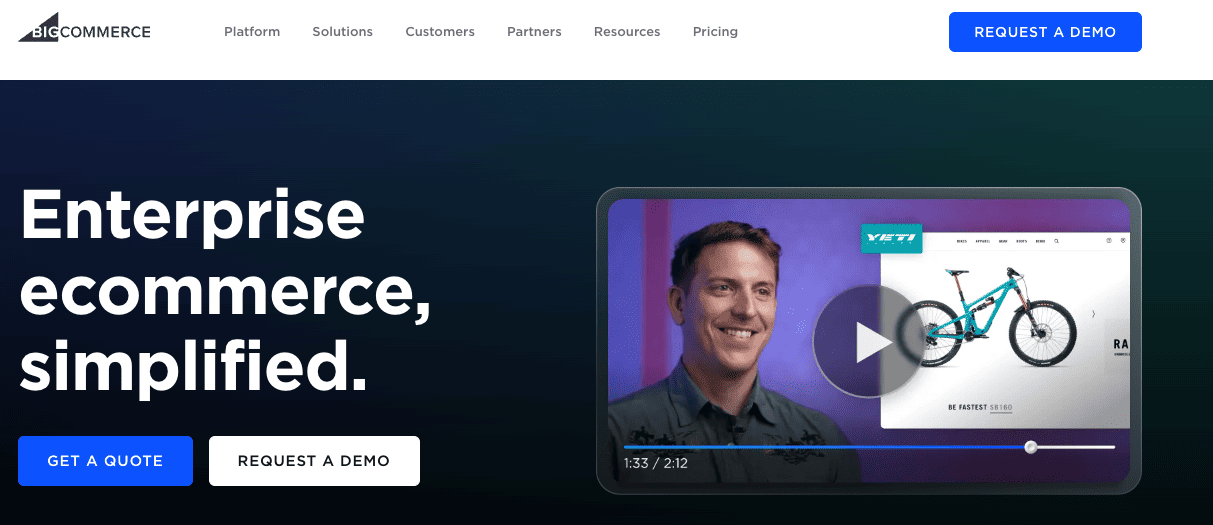
Pros
- No transaction fees on over 55 payment gateways
- Easy-to-use, drag-and-drop visual editor for storefront design featuring a few free or premium (paid) templates
- Fully customizable and rewritable URLs for all leading search engines
- Robust SEO features like microdata, 301 redirects, and CDN
- Access to several free apps and features like bulk pricing tools, product swatches, and advertising and analytics apps
- Customization options for B2B stores
Cons
- Initial setup may be slightly complicated for new users
- There are only 7 free themes available. You’ll be charged for the premium templates
- The standard plan doesn’t offer an abandoned cart feature
- A yearly sales threshold applies to pricing plans. You’ll automatically be upgraded to the higher plan if you cross the threshold, which may end up costing more
Ideal for
- small, medium, and large B2B & B2C stores planning substantial growth
- B2B and B2C stores requiring flexibility and minimum maintenance
- enterprises looking for connectivity with multiple apps
2. Wix
Wix is a popular website builder platform used by leading businesses worldwide. It offers an entire suite to build your website from scratch using Wix Editor and Wix ADI (Artificial Design Intelligence).
The key advantage of Wix is that users with limited technical and coding expertise can create responsive, attractive websites for their eCommerce stores.
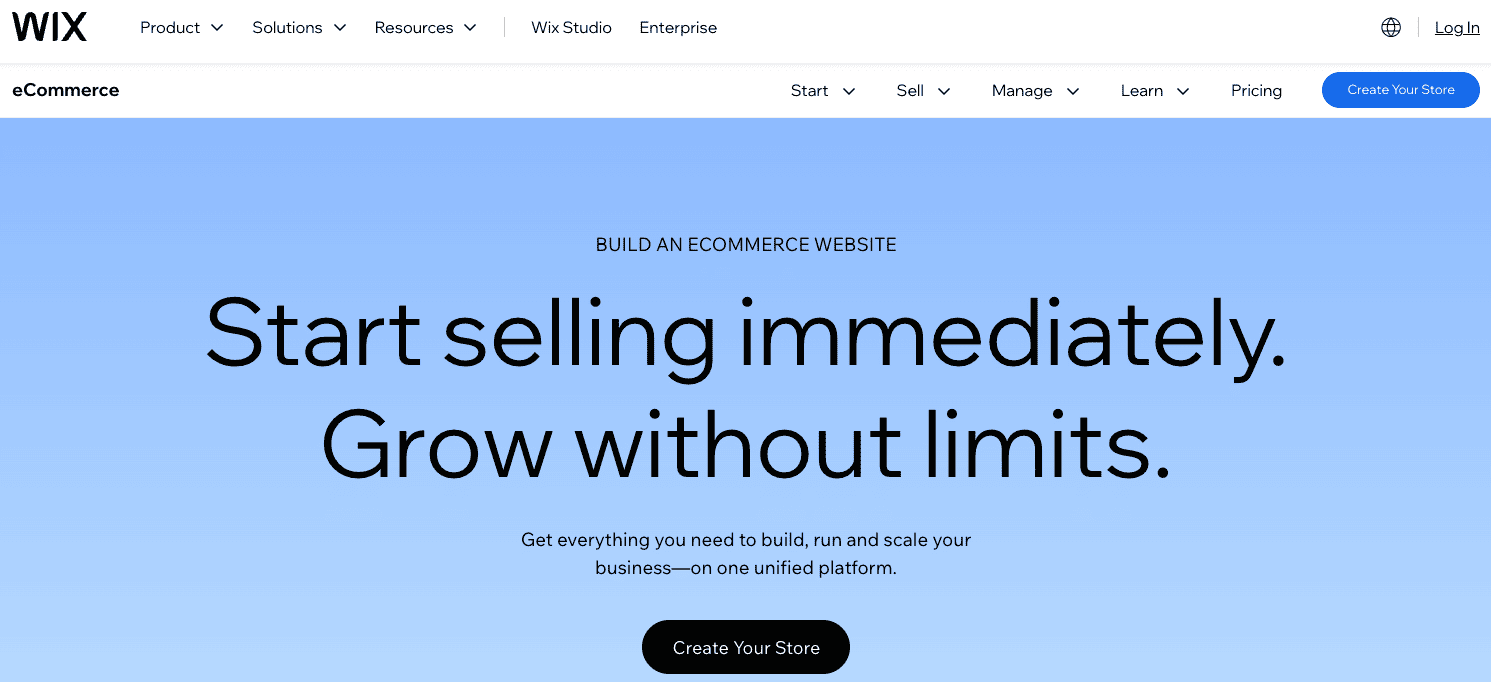
Pros
- Its user interface is simple and easy to use even if you lack technical expertise
- Over 900 customizable templates catering to diverse industries
- Smart suggestions and AI tools help with all stages of website creation
- Personalized SEO tools give you greater control over your URLs and search indexing
- Built-in email marketing suite
Cons
- Some templates may lack full responsiveness
- It offers over 500 applications, including WordPress plugins, but the number is limited compared to other players
- While desktop website speeds are high, mobile website speeds are slower
- The free plan doesn’t allow the use of your domain name
- You can’t change your templates while your website is live
- The premium plans are on the expensive side
Ideal for
- Newcomers and small businesses focused on website design with limited technical know-how
- Enterprises with a smaller inventory or content-driven website
- Wix Studio Editor is suited for professional website designers to include intricate, versatile design features
3. Squarespace
Squarespace is an all-in-one website builder tool that caters to small businesses and solopreneurs. It comes with in-built eCommerce, content management, and marketing plug-ins and offers various stunning templates. This, coupled with reasonable pricing plans, makes it an excellent option for small businesses.
Pros
- Its intuitive drag-and-drop editor requires minimal coding knowledge
- Offers over 140 award-winning design templates
- eCommerce features are fully integrated into all pricing plans
- Blogging feature includes scheduling posts, AMP support, and hosting podcasts
- Has a page limit of 1000, compared to 100 page limits in Wix
Cons
- Fewer advanced eCommerce tools compared to Shopify
- Limits on video storage in the basic plans might increase costs if you plan to host multiple videos
- Offers only one sub-navigation menu, making it unsuitable for websites needing deep menu hierarchy
- Only 47 external apps can be integrated, which is low compared to competitors
Ideal for
- Creatives and eCommerce stores prioritizing aesthetics
- eCommerce stores wanting to establish a strong online presence
- Businesses integrating blogs into their website
4. Magento (Adobe Commerce)
Magento has a rather dramatic corporate history. While it’s been around since 2007, it was purchased by eBay in 2011. It’s owned by Adobe and renamed Adobe Commerce in 2021.
It’s a feature-packed open-source platform that remains highly popular with store owners and small businesses. It offers a built-in CMS system for eCommerce stores. Big players like Nike, Liverpool FC, and Land Rover have also seen immense success using this platform.
Pros
- It is highly customizable and flexible, making it suited for complex catalogs
- It offers advanced and built-in SEO features, including creating unique category paths for URLs and automatic Google roadmap generation.
- Extensive omnichannel integration options, including mobile websites & apps, physical storefronts, and social media channels
- Active community of over 300,000 developers worldwide who offer support and clarifications
- Provides international scalability
- Supports B2C and B2B hybrid business models
Cons
- The technical barrier is relatively high, especially for beginners with less know-how
- It requires a dedicated server to host it, making it challenging for emerging brands or brands looking to experiment
- Hosting, maintenance, and plugin costs can add up to make it expensive relative to Shopify
Ideal for
- Established businesses that need a flexible, robust, and scalable platform
5. Ecwid
Ecwid has been around since 2009 and was acquired by Lightspeed in 2021. It is a popular SaaS eCommerce platform that now hosts over 897,000 shops.
The name Ecwid is a portmanteau for eCommerce widgets. As the name gives it away, it’s best used as a widget for an existing site. However, the free plan, zero added transaction fees, and easy user interface make it a great alternative to Shopify.
Pros
- Can quickly adapt to your site’s existing theme
- Easy to install and use with just a few HTML or Javascript lines
- It makes setting up your online store easier and faster
- Features like a shipping calculator are available even on the free plan
- Create responsive storefronts across devices
- Its POS functionality allows users flexible payment methods, including payment at physical locations
Cons
- Limited customization options and may not be suited for larger stores with complex catalogs
- Limited SEO capabilities, like the inability to edit URLs
- Only premium users get access to phone support
- You cannot create a complete eCommerce website using Ecwid
Ideal for
- Small businesses looking for add-on stores
- New and upcoming businesses with a website
6. PrestaShop
PrestaShop is a free eCommerce platform suited to small businesses on a tight budget. This open-source platform is available in over 75 languages since 2007. Today, it powers over 250,000 stores worldwide.
With over 15 years of experience, PrestaShop is a veteran in the game, and the team behind it offers great value and features. However, you must spend on a hosting package and domain name.
Pros
- Free of cost and open-source platform
- Easy to download and install even if you have slow internet connectivity
- Budget-friendly and minimal licensing requirements
- Pre-installed stater modules make it extremely easy to use
- Offers around 4000 plugins to get extra features ranging from admin tools to niche add-ons
- Supports multiple languages and currencies
Cons
- Design options may be limited for larger stores
- Steep prices for tech support on premium plans
- Investing in your own web hosting and domain name
Ideal for
- Tech-savvy businesses looking for a budget-friendly option
- Businesses looking to expand international distribution
7. WooCommerce
WooCommerce is one of the most popular, free, and open-source eCommerce plugins for WordPress. Users can create, manage, and launch online stores from their WordPress websites.
Launched in 2011, it has since emerged as a leader in the online marketplace and one of the top Shopify competitors. It gives users complete ownership over their content and is highly scalable, too.
Pros
- No transaction or recurring fees
- Seamless integration with WordPress
- Over 50k plugins to boost store performance and enhance functionality
- Large community of users offering extensive support
- Offers extensive customization options, including developing new extensions
- Includes plugins for SEO optimization
- Easily upsell products post-purchase
Cons
- Configuring and maintaining your store could be challenging without knowledge of HTML or CSS
- You’ll have to pay for domain hosting yourself
- You may not find a plugin with your requirements and may have to hire a developer
- Can’t use it on any other CMS platform
Ideal for
- WordPress users who require complete control and customization of their store
Read More: The Best eCommerce Stores to Spark Your Creativity
Plans and Pricing: An Overview of Shopify Competitors
Let’s explore the pricing tiers and plans of top Shopify alternatives so that you’re making a confident choice without breaking your marketing budget.
1. BigCommerce
BigCommerce offers four pricing tiers. All tiers promise zero added fees, unlimited storage and bandwidth, and unlimited staff accounts.
The basic plan begins at $29/month for stores with a revenue of $50,000. The Pro plan for businesses scaling up is $299/month. Opt for the 15-day free trial before you choose the right plan based on your revenue and needs.
Overall, BigCommerce can be a slightly more cost-effective solution, although its plans are similar. This is because you won’t be charged transaction fees on BigCommerce, and it includes more features in the Basic, Plus, and Pro plans. Finally, factor in your growth plans and invest in the right plan.
2. Wix
Wix offers four pricing tiers, with the basic plan (Light) at $17/month and the Business Elite plan at $159/month. The Light plan doesn’t support site analytics so that you can access the payments dashboard or their eCommerce platform in one place. Wix offers a 14-day free trial for new users.
There’s also a free plan, which can be useful for new businesses or for experimenting with a store before launch. The free plan carries Wix branding and ads, which may need to be better suited to establishing your brand name. It doesn’t include inventory management, transaction tracking, or links to Google Analytics.
3. Squarespace
Squarespace’s four pricing plans are lower than Shopify’s, with the Basic plan starting at $16/month, compared to Shopify’s $29/month. These rates are for annual payments, not monthly billing.
All plans promise zero transaction fees on online store transactions, except their Business Plan ($23/month), where you’ll be charged 3%.
Further, the Advanced Commerce plan ($52/month) lets you roll out subscriptions, advanced shipping, and discount features.
The personal plan is best suited for a blog or portfolio without eCommerce functionality. The Business and Commerce plans are best suited to eCommerce enterprises.
You might have to invest a bit on added costs like domain name, email marketing, and third-party integrations with Squarespace.
4. Magento (Adobe Commerce)
Adobe offers different versions of Magento services. The Magento Open Source platform is free to use. You’ll pay for the services and features you’ll use. In addition, you’ll have to invest in hosting your domain name, card payments, web hosting, and any other customizations.
Adobe Commerce offers customized services for eCommerce stores looking for functionality. You’ll have to fill out their form, wait for their sales team to contact you, and create a pricing plan based on your Average Order Value (AOV) and Gross Merchandize Value (GMV).
Adobe Commerce would be perfect for high-volume stores planning to scale up. However, Shopify, Squarespace, or BigCommerce could be user-friendly and cost-effective in the long run.
5. Ecwid
Ecwid offers a free starter plan and three paid plans. The free plan lets you set up your store, gives you a mobile responsive shopping cart, and allows social media advertising except Instagram and Facebook stores.
The paid Venture plan starts at $14.8/month and includes mobile point of sale and Android and iOS app store management. The Unlimited plan is priced at $82/month and includes automatic cart recovery and a branded mobile shopping app.
However, Ecwid won’t be able to power your eCommerce website entirely. So, while the monthly costs are lower than those of Shopify, consider whether you have a functional website that Ecwid widgets can take to the next level. Shopify also offers a 3-day trial period, which Ecwid does not.
6. PrestaShop
It’s entirely free to start up shop using PrestaShop. However, you must pay for your domain name, hosting, and SSL certificate. As part of their hosting package, PrestaShop offers a free domain for the first year with their paid hosting plan. You can also offer flexible hosting options through their partnership with Hostinger and IONOS 1&1.
These are some of the added costs you’re likely to incur:
- Modules for payment gateways, shopping features, or marketing: $30-$500
- Templates: $50-$300
- Customer support: $290-$970
- Transaction fees: 2.9%-3.9% per transaction, depending on the gateway
Shopify also charges transaction fees for some gateways. So, consider all these add-ons before choosing the right platform for your needs.
7. WooCommerce
WooCommerce is free to add to your WordPress site, but several add-on costs exist. Let’s break down some of the costs you’ll incur:
- Hosting: between $10-$70/month
- Domain: nil if you’re choosing a hosting plan; between $9-$20/year for a separate purchase
- Themes: $200 one-time payment for a premium theme
- Shipping: Between $0-$110/year based on your requirements
- Communication costs: up to $300/ year based on your needs
- SEO plugin: up to $79/year based on SEO needs
This is an estimate based on average costs. Your investment could increase if you’re looking for added customization features or hiring a developer.
Read More: 6 Best eCommerce Platforms for Startups
Shopify Alternatives: Feature-by-Feature Comparison
So, what features do Shopify alternatives offer you? Your decision should be based on the platform that offers the right features within your budget. Here’s a handy comparison table to give you an overview of each alternative.
| Platform | Ease of Use | Customization | SEO capabilities | No. of payment gateways | Premium template costs | Scalability | Domain Hosting |
| Shopify | 4.8/5 | Moderate | Very Good | 100+ | $140-$500 | Excellent with lots of features, but limited pricing plans | Included |
| BigCommerce | 4.8/5 | Moderate | Very Good | 65+ | $135-$235 | Excellent, can handle 1000s of SKUs each hour | Included |
| Wix | 4.4/5 | High | Good | 300+ | $20-$500 | Good, but limited features for large catalogs | Included |
| Squarespace | 4.0/5 | Moderate | Good | 100+ | $12-$40/month | Good, but limited features when traffic increases | Included |
| Magento (Adobe Commerce) | 4.0/5 | High | Very Good | 190+ | Custom | Excellent, highly scalable, and customizable | Host Separately |
| Ecwid | 4.4/5 | Low | Good | 40+ | Up to $99/month | Good, but best suited for small and mid-size businesses | Included |
| PrestaShop | 2/5 | Very High | Good | 250+ | Custom | Good, but requires higher technical expertise to maintain large stores | Host Separately |
| WooCommerce | 4.5/5 | Very High | Excellent | 100+ | Custom | Good, but requires separate hosting and technical expertise | Host Separately |
What Users Are Saying: Success Stories and Reviews
Now that you have an overview of the key features, let’s look at the word on the street about Shopify alternatives. We’ll look at overall ratings, customer reviews, and success stories.
1. BigCommerce
Trust Radius Rating: 7.4/10 | G2 Rating: 4.2/5 | Capterra Rating: 4.4/5
Overall, verified reviewers rated BigCommerce quite high for ease of use and customization features. Several users rated their customer service highly, while others were dissatisfied.
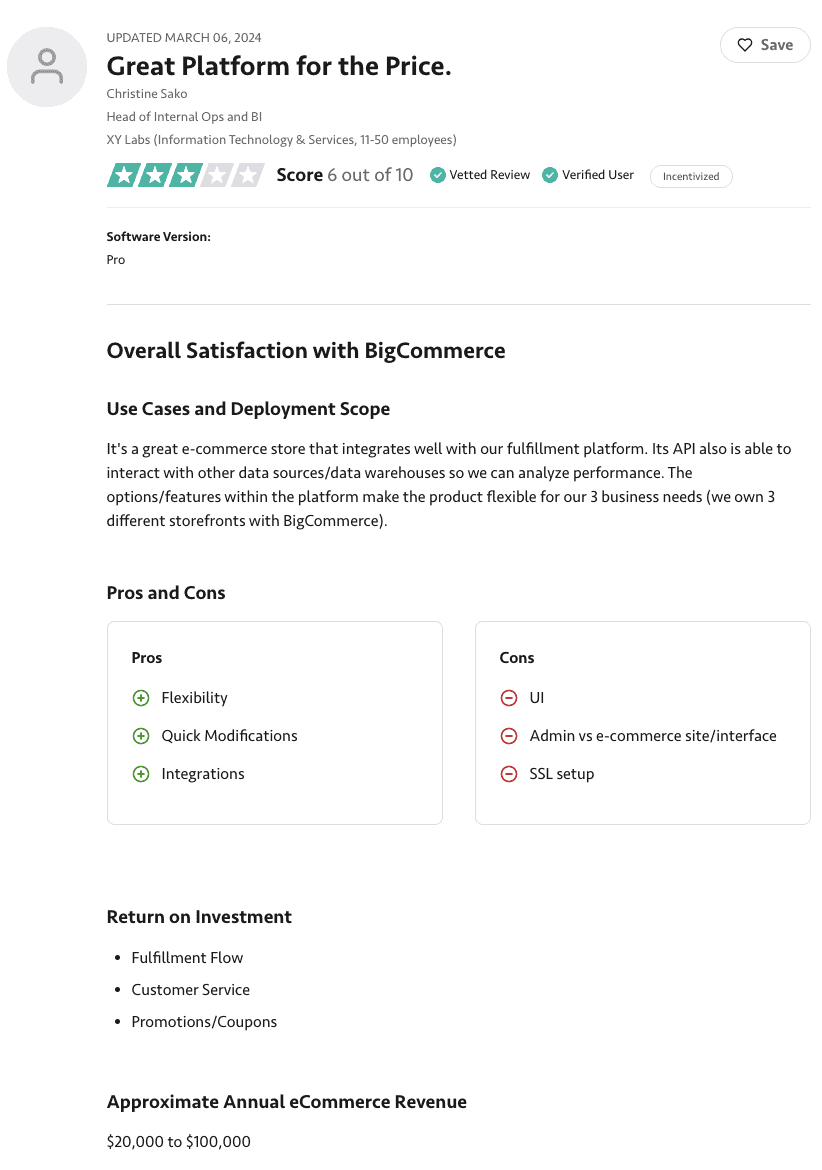
While this reviewer viewed the UI as a negative, they also mentioned how it helps the storefront stand out compared to Shopify. This user would recommend BigCommerce to others with similar annual revenue, with a caveat about their customer service.
Finally, we’ll leave you with a feature-by-feature comparison of BigCommerce and Shopify based on average user ratings for both platforms.
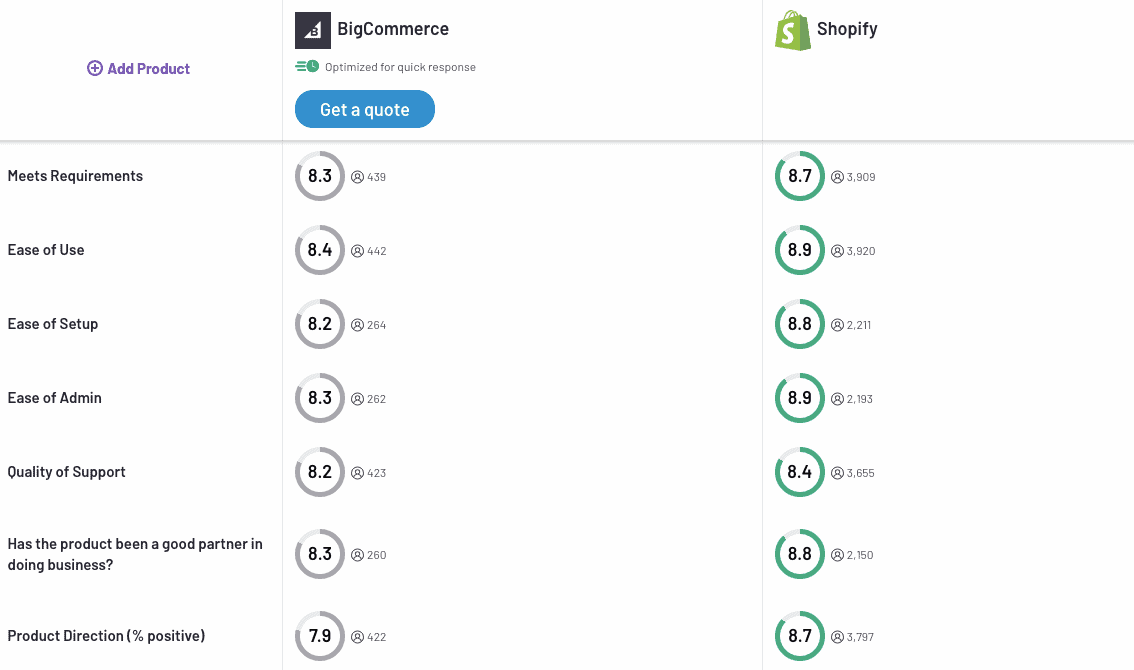
2. Wix
Trust Radius Rating: 8.7/10 | G2 Rating: 4.2/5 | Capterra Rating: 4.4/5
The top user reviews of Wix highlight how easy it is to use and the wide variety of excellent, responsive templates. Several customers pointed out the limitations of their customization features. Here’s a review from G2 featuring a small business owner’s experience with Wix.
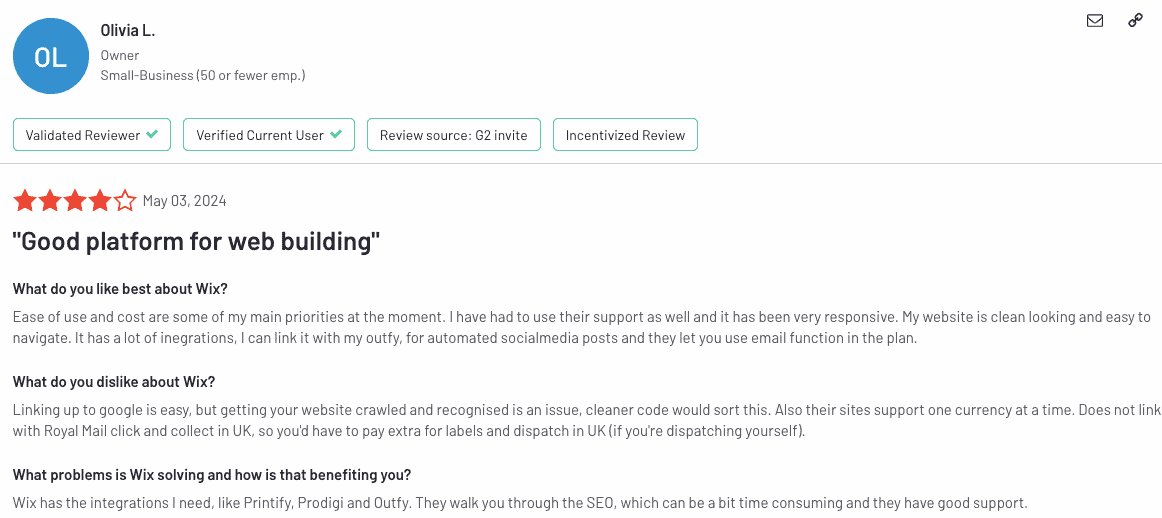
Let’s look at what users say about features offered by Wix compared to Shopify.
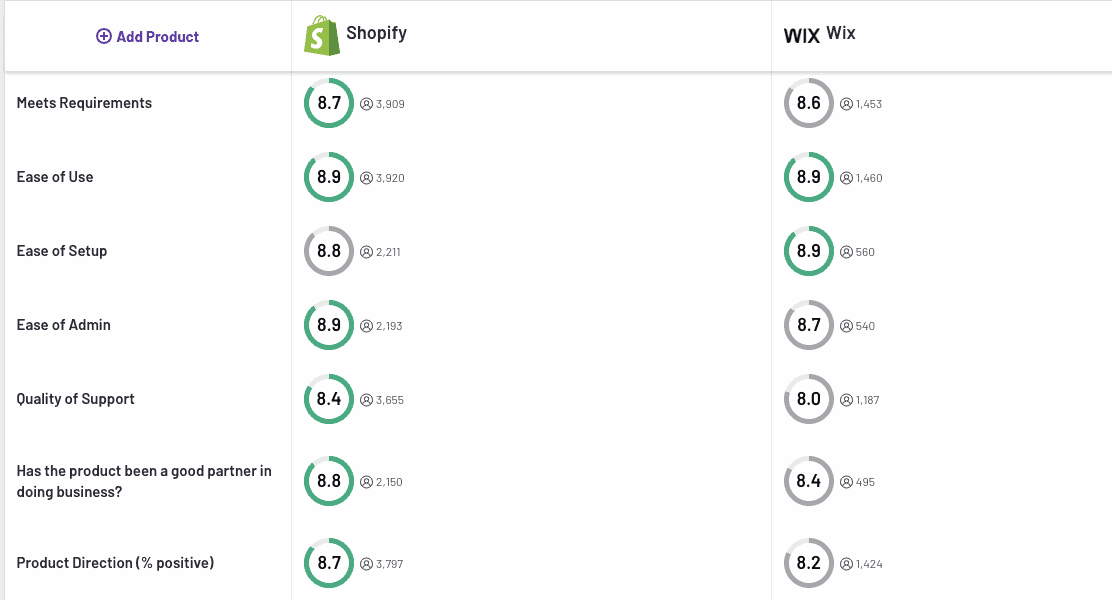
3. Squarespace
Trust Radius Rating: 8.4/10 | G2 Rating: 4.4/5 | Capterra Rating: 4.6/5
Regarding ease of use, most reviewers are highly satisfied with Squarespace. However, many users report the customization features as less than satisfactory. Here’s a vetted user review from Capterra, who switched to Squarespace from Shopify.

Users were mainly satisfied with the SEO capabilities and how quickly and effectively they could launch websites using Squarespace.
However, some customers found that customer care could have been more responsive. Some edit and design features also proved too complicated for some users with no knowledge of coding. Here’s a features comparison to Shopify based on average user ratings.
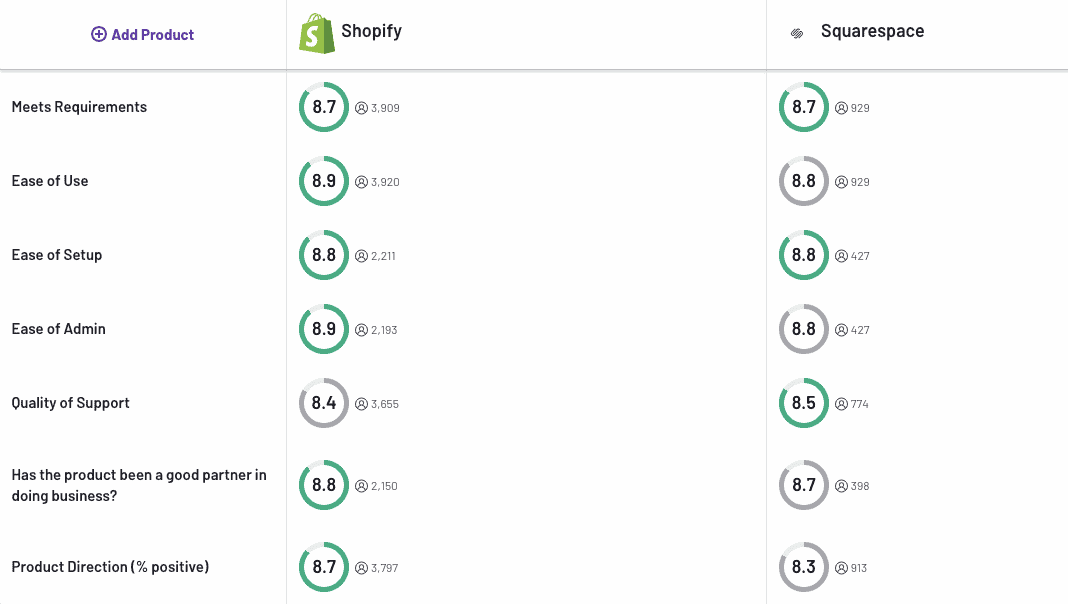
4. Magento (Adobe Commerce)
Trust Radius Rating: 8.2/10 | G2 Rating: 4.0/5 | Capterra Rating: 4.3/5
Users highly rate Magento for its eCommerce integration and eCommerce business management features. Its payment management features are also rated some of the best in the market today. Several users considered alternatives like Shopify and PrestaShop before deciding to use Magento.
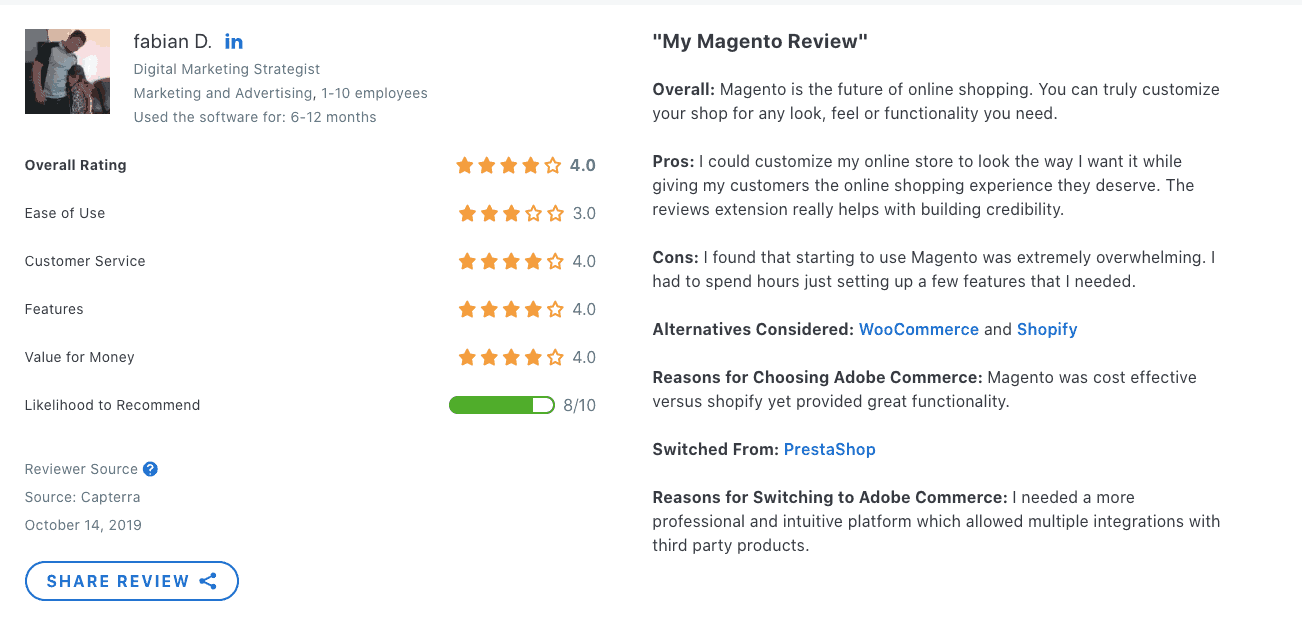
Here’s a summary of user ratings for each feature from G2.
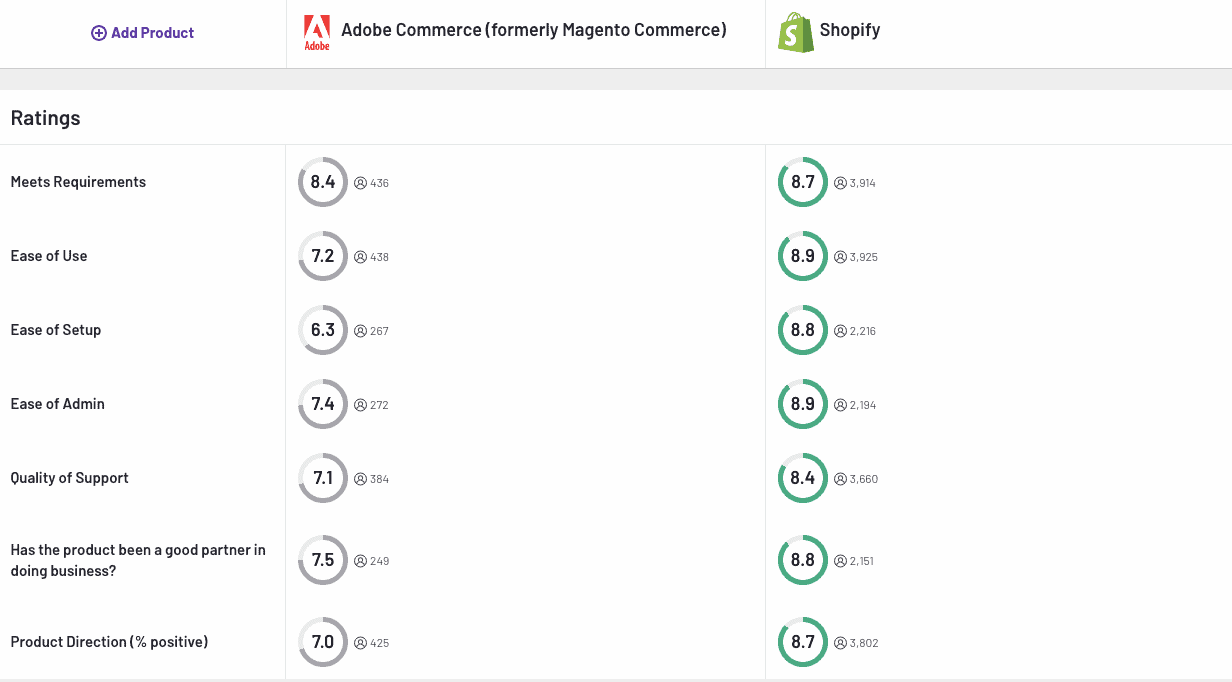
Read More: BigCommerce vs Magento: Features, Pricing, and More Compared
5. Ecwid
Trust Radius Rating: 10/10 | G2 Rating: 4.7/5 | Capterra Rating: 4.6/5
Ecwid was easy to use for eCommerce retailers with limited technical knowledge. Ecwid made it easy for platforms to set up shop and start selling online quickly. Their free plan has a decent amount of features for stores starting.
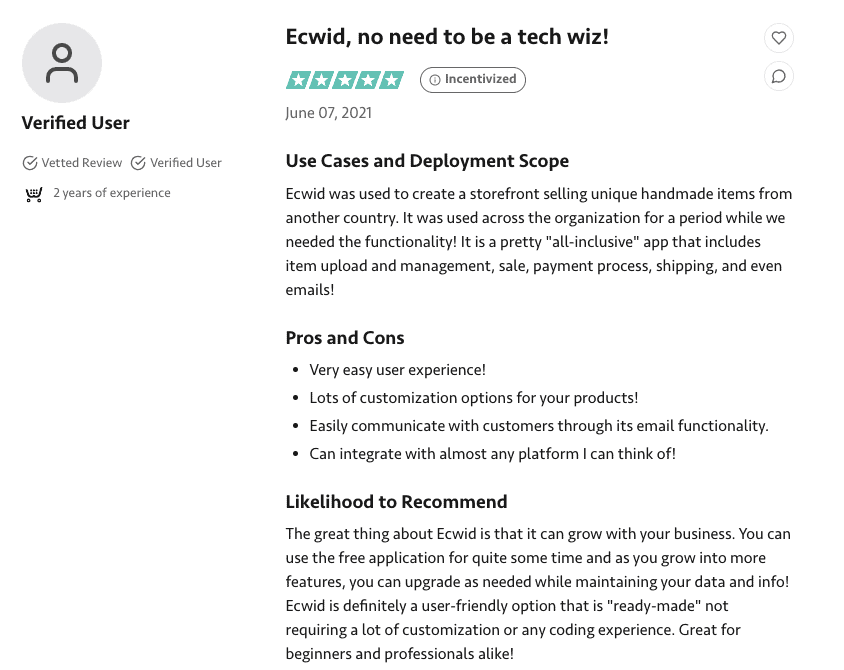
Several users found Ecwid to be scalable for their stores. However, some stores with more complex catalogs found limited functionality regarding social media marketing features and the many upgrades required.
Ecwid scores relatively high in average user ratings for key features; however, remember that you cannot create a site from scratch with Ecwid, unlike Shopify.
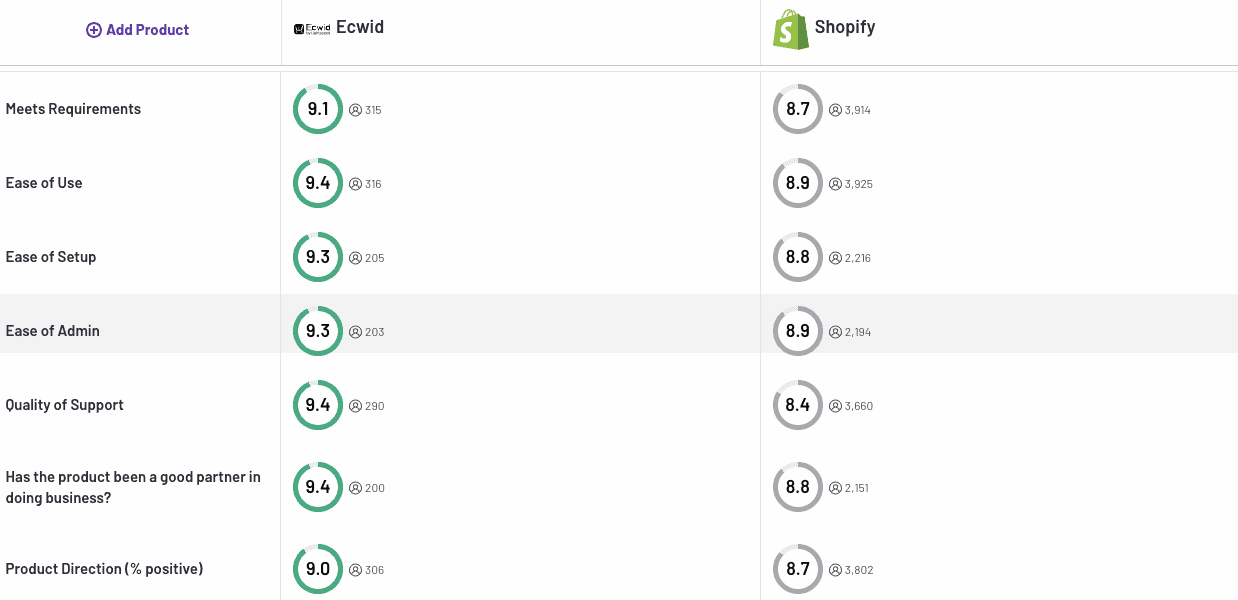
6. PrestaShop
Trust Radius Rating: 6.9/10 | G2 Rating: 4.3/5 | Capterra Rating: 4.3/5
Users highly rate PrestaShop for ease of use and customization features.
One of the biggest success stories of PrestaShop is from a real estate company that used PrestaShop to launch a storefront. They enabled users to add properties and enable online payments.
As a result, the company was able to streamline sales and close several deals quickly due to the ease of payments. However, the company later switched to a direct inquiry-based system in the following years.
For eCommerce stores, users recommend PrestaShop for customizations and creating a storefront that matches their needs.
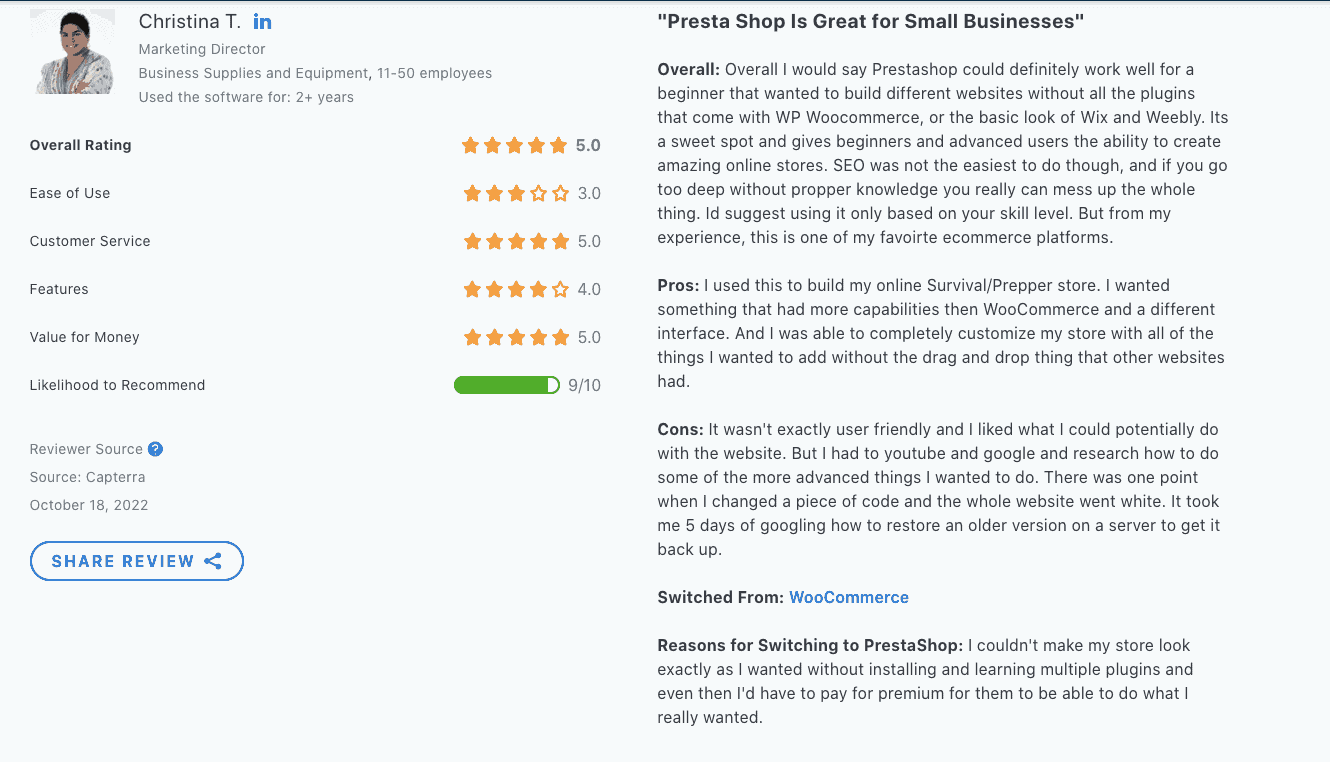
Here’s a comparison of the average user ratings for each feature of PrestaShop and Shopify.
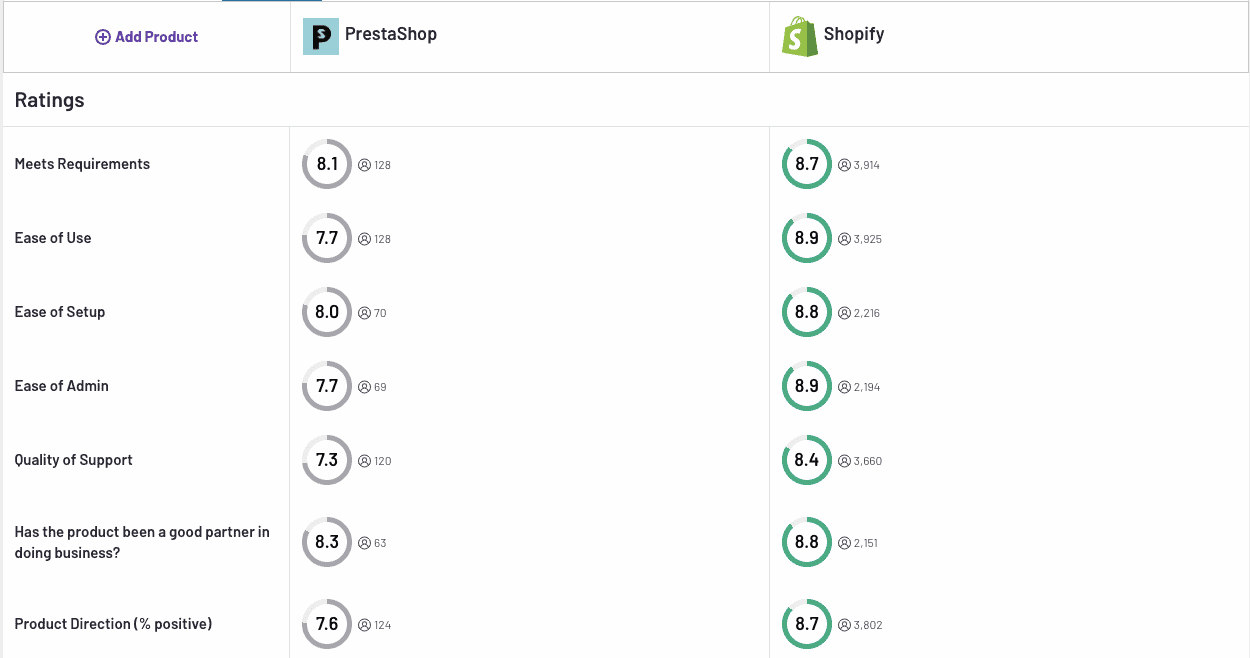
7. WooCommerce
Trust Radius Rating: 7.9/10 | G2 Rating: 4.4/5 | Capterra Rating: 4.5/5
Overall, users have benefited from WooCommerce’s ease of integration with other tools, competitive commission rates, and excellent eCommerce management features. On the downside, some users found the technical documentation lacking. Its monthly fees are also slightly higher compared to those of its newer competitors today.
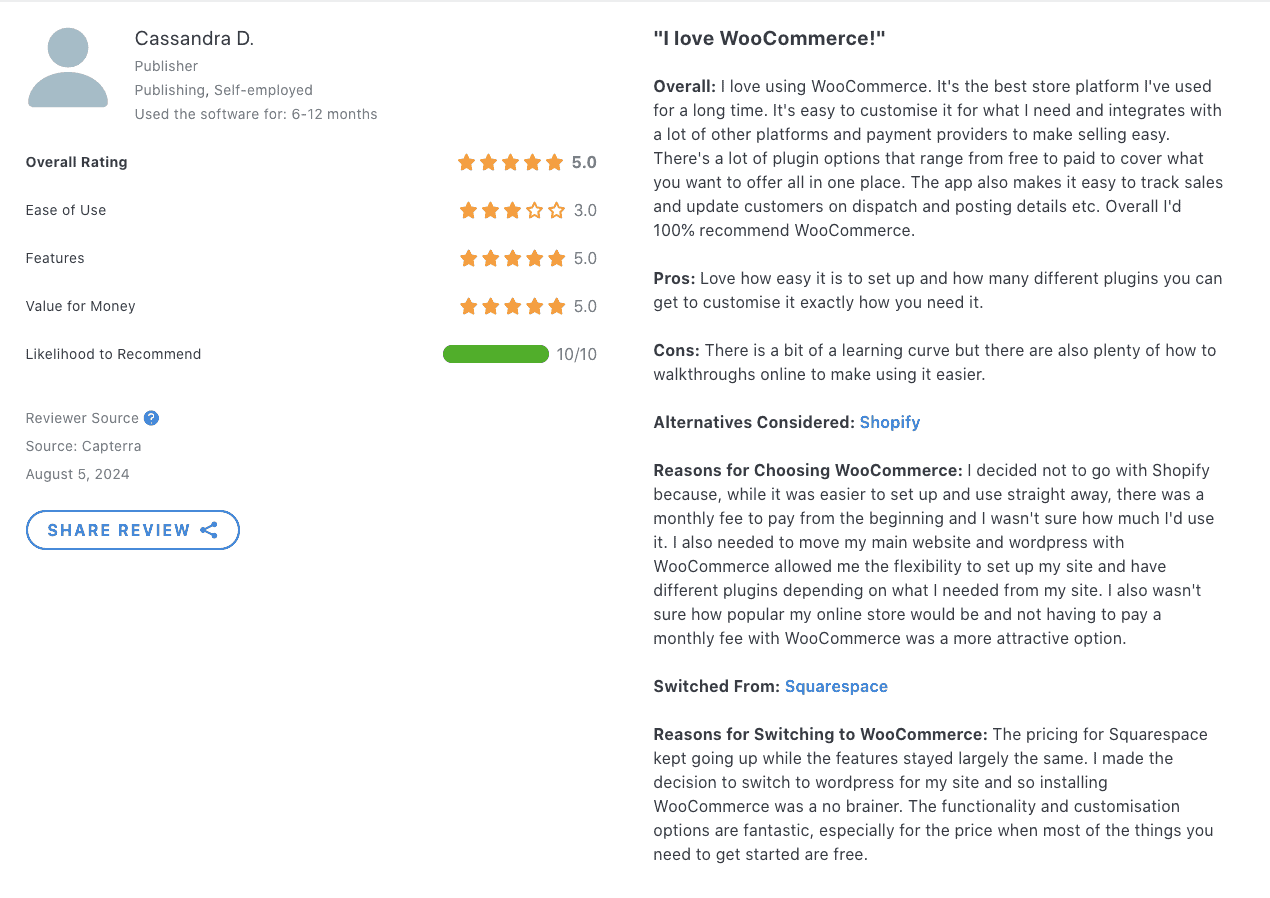
Another review from a mid-size eCommerce company also had several benefits to share. However, they struggled with customizing automated emails for their campaigns.
On average, users rate WooCommerce features quite competitively with Shopify, especially regarding meeting requirements and product direction.
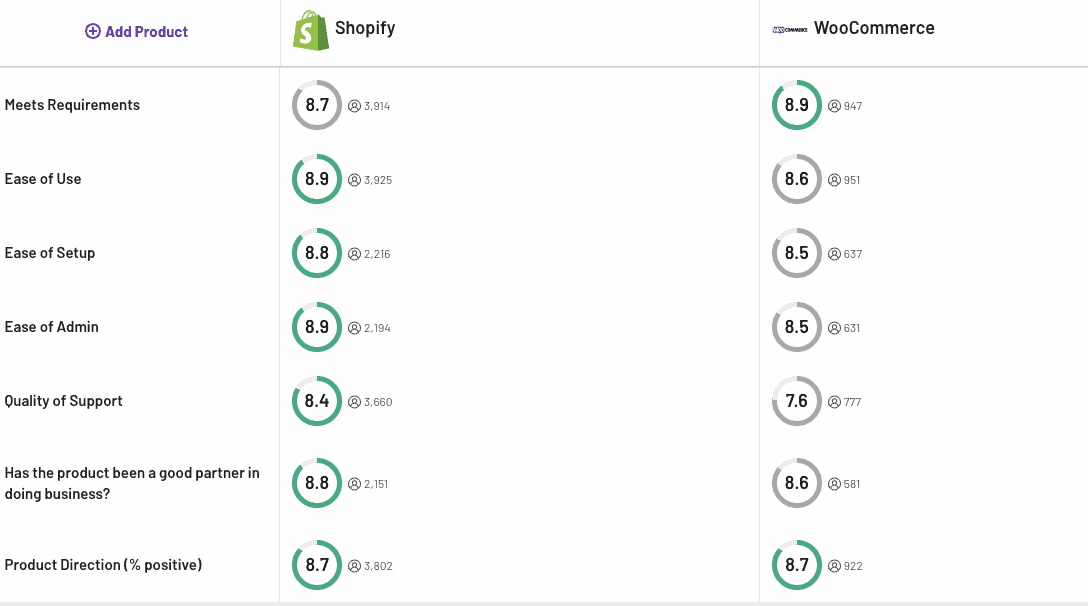
Read More: eCommerce Pricing Plans Comparison — Features, Pricing, Pros and Cons
How to Pick the Right Shopify Alternative for Your Small Business
Ultimately, no matter how many user reviews you read, only you can select the right Shopify alternative for your unique needs as a company. First, identify and set clear goals in terms of expectations on what the right platform can provide for your store.
There would be several factors to consider, such as your budget, expected profit margins, short-term and long-term sales goals, and how your company plans to scale up in the upcoming quarters. Remember to feature in your existing platforms and integration options. Consider the technical skills you already have at your disposal or whether you’re willing to invest in hiring a developer to scale up your store.
Finally, consider your customer experience and ease of navigating your storefront before selecting your platform, as this, too, impacts your bottom line.
Read more: Magento vs Shopify Buying Guide: Which is Better and Why?
Conclusion
So, the bottom line is that you have several feasible Shopify alternatives if you’re dissatisfied with Shopify for any reason.
You have the power and data to determine the most suitable platform for your eCommerce needs. Leverage the free trial option if you’re not fully sure about migrating to another platform. After all, it is a time-consuming effort.
Alternatively, you can also opt for the free version of a platform to experiment on a storefront before upgrading to the premium version if it suits your brand.
FAQs
What are the main limitations of Shopify that these alternatives overcome?
The main limitations of Shopify that these alternatives overcome are:
- Limited scalability for stores with larger catalogs
- Flexible payment models without added processing fees
- Better customization options for larger stores
- Increased control over SEO elements like sitemaps and canonical tags
- Increased data portability and migration
- Flexibility for multiple business models
Can I migrate my Shopify store to another platform easily?
You can migrate from Shopify to another platform. However, there needs to be a way to quickly and easily bulk-move everything from Shopify in one go. Follow these steps to migrate your Shopify store to another platform:
- Create a backup using the Shopify App Store. You can export your product data in CSV format but can’t create your entire store with another platform. But, it is still a good idea to back up data.
- Import your CSV product data with your new platform. Remember that passwords can’t be imported, so you’ll have to reset all your passwords to access your data on the new platform. You’ll have to import your data manually.
- Test and verify your migration to ensure you’ve transferred all the relevant data.
- When you’ve tested the website and configured it appropriately, redirect your domain from your Shopify store to your new domain.
What are the best Shopify alternatives for a business with a large inventory?
Some of the top Shopify alternatives for a business with a large inventory include:
- WooCommerce
- BigCommerce
- Squarespace
- Ecwid
- Magento (Adobe Commerce)
- PrestaShop
Are there free Shopify alternatives that offer similar features?
Yes, several Shopify alternatives offer similar features. Top Shopify alternatives with similar features include:
- BigCommerce
- Wix
- Squarespace
- Magento (Adobe Commerce)
- Ecwid
- PrestaShop
- WooCommerce
How do eCommerce platform fees impact overall profitability?
The eCommerce platform fees significantly affect your profitability and the profit margin of each sale. How it impacts your profitability depends on several factors. For example, a platform offering low transaction fees but higher monthly fees may not be feasible for small businesses and can affect their profitability. Here are some tips to find out how platform and transaction fees will affect your bottom line:
- Consider the overall cost structure, including add-ons and hidden fees, from the outset.
- Compatibility of the platform with your existing structure and payment gateways.
- Customer experience implications of shipping charges and overall UI.
- Request volume discounts, be bold, and negotiate.

